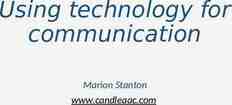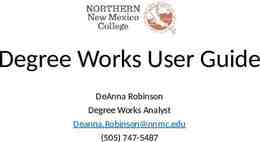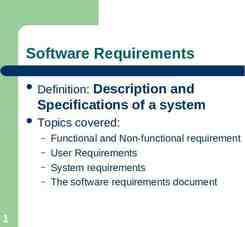Self – Employment Potential Pathway to Success MICAH Williamson,
27 Slides1.99 MB

Self – Employment Potential Pathway to Success MICAH Williamson, Self-Employment Rehabilitation Specialist (256) 549-7783 [email protected]

Self Employment Manual The manual is on SharePoint : (go to programs, VRS, shared documents, VR self-employment manual) In addition to the manual, there is a 2 page overview which includes a 14 step review of the Self Employment process. ADRS Self Employment Plans are FOR PROFIT only. updated 10/18/2016

Some History of VR Self Employment Jim Searcy – Chinchilla Business VR Counselor – Pig Business Lamona Lucas – Milk cow Big Costs – Little Results. But there are success stories!

3 Types of Self Employment 1. Supported Self Employment (Supported Employment IPE) 2. Traditional Self Employment (Self Employment IPE) 3. Maintaining Existing Self Employment (Self Employment IPE)

Score Magazine states: A good idea is a wonderful starting point; however, it takes hard work, research, planning and successful implementation strategies to turn your idea into a profitable business.

THE IMPORTANCE OF PROPER PLANNING Shapes the end results Provides the best path Gives you a road map to follow Provides a bench mark for evaluating progress If you don’t know where it is your going, any road will get you there!

TOOLS FOR SUCCESS Self Employment manual Small Business Administration (SBA) Service Corps of Retired Executives (SCORE) ADRS Staff – Unit Supervisors, Rehabilitation Specialist, BRC, Benefits Counselors / CWIC Self Employment questionnaire Begin Developing your Business Plan questionnaire

Preliminary Assessment Questions Supported & Traditional Self Employment 1. Why do you think self-employment is the best vocational goal for you? 2. Why have you selected this particular business? 3. What experience have you had in this or related kinds of business? 4. What education, training and certifications do you have related to this business? 5. What has been your experience in dealing with the public? Do you enjoy meeting the public? 6. How many hours do you anticipate you will need to work each week in both establishing and maintaining this business?

Preliminary Assessment Questions Supported & Traditional Self Employment 7. What income are you expecting initially from this business? What do you expect will be your annual income a year from now, 2 years? 8. What financial resources will you have available in establishing your business? Do you have friends or relatives prepared to invest in your business? 9. Will you consider borrowing money from the Small Business Administration or other sources? 10.Do you think you will need help in the continued operation of your business? Where might this help come from and in what areas would you utilize such assistance?

Questions Maintaining Existing Self Employment Maintaining Existing Self–Employment is for: Individuals who are already successfully self-employed but experience a disabling condition that has the potential to jeopardize their business. Self employment services cannot be provided solely for business expansion or enhancement of an existing business. Self employment services cannot be used for maintaining an existing business when replenishment of supplies or replacement of equipment is all the consumer needs.

Preliminary Assessment Questions Maintaining Existing Self Employment 1. What problems is the business experiencing now? Why do you need ADRS assistance? 2. Why do you feel that continued selfemployment is the best vocational goal for you? Is this business something you can continue to do? 3. How many hours do you anticipate you could work each week to continue operation of your business? Do you need accommodations? If so, what?

Preliminary Assessment Questions Maintaining Existing Self Employment 4. Will you need retraining to maintain this business? Do you need to change your business focus? 5. What specific tasks/jobs do you perform within this business? What jobs/tasks do others do? What skills/training is needed for employees? 6. What income have you been receiving from this business? What do you expect your income to be this year? A year from now? 7. What sort of cash flow/resources does the business have? What is your financial liability? How has disability affected cash flow or business productivity?

Questions Maintaining Existing Self Employment 8. What financial resources do you have available in maintaining your business? Do you have friends or relatives prepared to invest in your business? 9. What is your credit score? 10.Do you think you will need help in continuing operation of your business? Where might that help come from and in what areas would you utilize such assistance?

Developing your Business Plan Answer the following questions to help clarify your business idea for both you and your VR These questions are the beginning plan. You will be able to answers as you develop counselor. of your business provide more in-depth your business plan. What is your proposed business? How much money will you need to start the business? How much can you contribute? What are likely sources of start up capital?

Business Plan Development The CONSUMER has the primary responsibility for developing the business plan but is encouraged to use agencies such as the local Small Business Administration (SBA) and Service Corps of Retired Executives (SCORE) chapter for assistance with plan development.

Business Plan Components 1. Executive Summary – succinct explanation of the business 2. General Company description – Mission statement, objectives, legal form of ownership (the VR consumer must retain at least 51% ownership and ADRS funding is based on the percentage of the business the customer owns. If consumer owns 75% of the business then 75% of the total start up cost is used for ADRS funding calculations). Start-up expenses and capitalization 9. Financial Plan: income and expense projection, cash flow, 2nd year income

Approval Process for Business Plans (Prior to IPE Development) Proposed business plans of 7,000 or less may be reviewed and approved by local VR field supervisor. Proposed business plans in excess of 7,000, must be reviewed by the unit supervisor and self-employment specialist who will coordinate review with business consultant. Proposed business plans 50,000 must be approved by the division’s assistant commissioner. * It is recommended that the supervisor, self-employment specialist, and business consultant review the proposed business plan prior to offering feedback to the consumer.

Self Employment Funding Tier 1 ADRS must not be the sole source of capitalization funds Start-up costs of 7,000 or less: ADRS can fund 100% of initial start up costs up to 7,000 Consumer provides in-kind funding such as use of their personal vehicle in business development and business operation, use of real estate, equipment, tools already owned. Sweat equity such as meeting with benefits counselors, SBA, SCORE personnel, research and developing a business plan.

Self-Employment Funding Tier 2 Start-up costs of 7,001 - 15,000 ADRS can fund 100% of first 7,000 50% of additional start up costs up to 15,000 Example: Business has 15,000 start up costs: ADRS provides 100% of first 7,000 7,000 ADRS provides 50% of next 8,000 4,000 Total ADRS support 11,000. Consumer contributes 4,000

Self-Employment Funding Tier 3 Start-up costs 15,000 ADRS can fund 100% of first 7,000 50% of start up costs over 7,000 up to 15,000 25% of start-up costs over 15,000 Example: Business has 30,000 start-up costs ADRS provides 100% of first 7,000 7,000 ADRS provides 50% of next 8,000 4,000 ADRS provides 25% on next 15,000 3,750 Total ADRS support 14,750. Consumer contributes 15,250

Consumers receiving benefits (SSI & SSDI) If the consumer is receiving SSI and / or SSDI, it is advisable to refer to a benefits counselor in the business plan development stage. Input from the benefits counselor is a key component of the business plan.

Appropriately estimating Income WIOA states (pg. 63 & 685) Competitive integrated employment means work that - . In the case of an individual who is self employed, yields and income that is comparable to the income received by other individuals who are not individuals with disabilities and who are self-employed in similar occupations or on similar tasks and who have similar training, experience, and skills .

Calculation of potential income A major reason for business failure is over estimation of potential income and under estimation of actual expenses. Benefits counselor’s need an accurate estimate of projected income because with SSI and Self employment plans, the consumer must report potential earns up front. Consumer needs to be on trajectory to reach estimated income when case is closed.

Employed Status Employment begins the first day of business start-up. VR services may be utilized during employment.

Criteria for Closure It may be difficult to determine when an individual pursuing selfemployment is stable enough to consider closure. Businesses take time to develop and become profitable. Wage data may be misleading because many business owners work more than 40 hours per week and income received is reinvested in the business. In order for a self-employment case to be considered successfully closed, the consumer must meet the core indicator plus 1 of the additional indicators. Core Indicator: The consumer has sustained the business for 90 days, the consumer’s income is comparable to the income of people without disabilities in similar occupations, and income is being reinvested into the

Additional criteria for closure Additional Indicators: 1. SSI/SSDI benefits are terminated. 2. Consumer has experienced a decrease in public benefits (SSI, TANF, SNAP, housing). 3. Equity in the business has increased. 4. Consumer and counselor agree the monthly gross earnings are satisfactory for closure.

Self – Employment Potential Pathway to Success Micah Williamson (256) 549-7783 [email protected]






